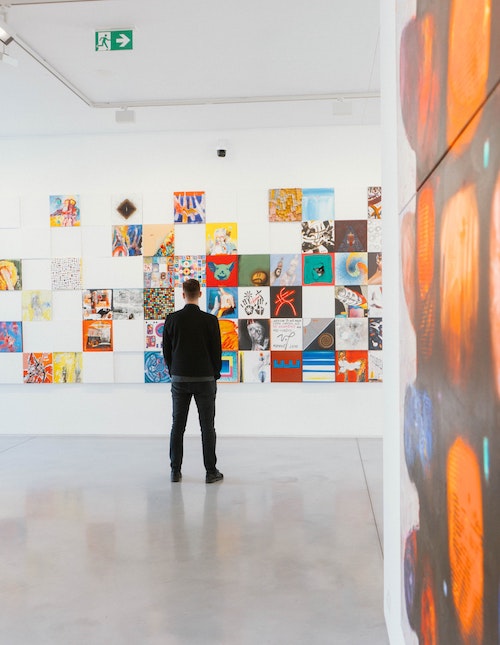
Buying Art? Keep These Four Tips in Mind
So you’re ready to invest in art. Whether you’re outfitting your first solo apartment, building a collection as a couple or marking a special occasion, you’ll want to brush up on the basics for purchasing artwork that’s meaningful to you — and has the potential to increase in value. Check out this beginner art buying guide for the steps to follow as you start your hunt for the perfect piece.
Find your focus.
You don’t need to be an expert on the art history canon to experience, appreciate or purchase artwork. The essential thing you must know, however, is what you like. With so much artwork available, your personal style should be your guiding light.
“A lot of people spread themselves too thin. If you’re interested in prints or photography or sculpture or women artists in the Southeast, find a niche that really speaks to you,” says gallery owner and art appraiser Spalding Nix. “Once you have that, getting out there and looking is the most important thing. And that’s the fun part. It’s research but with a glass of wine in your hand.”
Get a sense of the scene — and your own taste — by regularly attending exhibitions, gallery openings and artist talks. Social media is also a rich resource for training your visual eye. Search for hashtags on Instagram or TikTok, from #fineartphotography to #contemporarysurrealism, to refine your preferences and find contemporary artists. Jot down notes or take screenshots of your favorites, then step back and notice the commonalities. Figuring out your area of focus sets your collection up for success over the long term.
Set your budget.
If you’re creating a new abode from scratch, interior designers recommend artwork take up 10 to 15 percent of your total decorating budget. Otherwise, the number is up to you, and can set the tone for whether you want to spring for a more expensive original, search for an affordable limited-edition print or invest in something totally custom to match your vision.
No matter what you want to spend, there is artwork out there for you. An increasingly virtual art world has also led to greater transparency in pricing, so you can search online galleries and marketplaces to get a sense of the market. Browsing in person? Don’t be afraid to ask what a particular piece costs. If it’s out of your price range but you love the artist, look into smaller works or different mediums (such as on paper instead of canvas) to find the one that’s right for you.
Having your budget in place can determine where you should look — and as an impulse check when a statement piece catches your eye at an auction or art fair.
Know your measurements.
Where do you want to place your artwork when you buy it? Before you find your must-have piece, make sure you have your measurements on hand — bringing home a piece then finding it doesn’t fit your space is a surprisingly common first-time buying mistake.
Here’s the magic formula: Interior designers say wall art should fill 60–75 percent of the available wall space. Measure the height and width of the available wall space (that means the part not covered by furniture or other décor) then multiply the number by both 0.60 and 0.75 to find the range.
Hanging artwork over a sofa, bed or mantel? The width of the piece should be two-thirds to three-fourths of the width of the furniture or fireplace. That means you can multiply the width of your couch by 0.66 or 0.75 to find the perfect canvas size.
Consider emerging artists.
Buying artwork means you’re directly supporting an artist’s career and encouraging creative expression. Consider looking into emerging artists for your collection to increase the impact of your patronage. Bonus: Buying an affordable piece from an up-and-coming artist may increase in value as their career blossoms.
When looking for emerging art to buy, go where the artists go. M.F.A. shows are great places to scout for new talent (and you might rub shoulders with gallerists who are doing the same.) Check out social media to find out who art-world figures you admire are following. You can also search platforms where creatives post portfolios and grow their business. Online marketplaces like Artrepreneur, with more than 120,000 members, offers a wide range of artists to select from according to filters that match your focus – and prizes accessibility for traditionally excluded groups. Visit virtual artists’ studios to see what resonates with you, then shop directly from showrooms. Check the resume and portfolio features on members’ profiles to get a sense of their career trajectory. You might spot an artist on the rise.
No investment is a guaranteed bet — especially in the largely unregulated art market. A piece of artwork also takes longer to accrue in value. So play the long game: Lean toward purchasing a piece you’ll be happy to live with and look at every day. Happy hunting!
This guest post for Related Life features reporting and editorial contributions by Allison Stice, editorial director at Artrepreneur, a global digital marketplace and membership platform that empowers artists to succeed and connects art buyers with curated works. As the first platform for the arts to earn Certified B Corporation status, Artrepreneur is a purpose-driven business dedicated to creating an inclusive community of creative talent from around the world. Follow @artrepreneur_og or visit artrepreneur.com for more.
Be sure to follow Related Life on Facebook and Instagram for the latest events, news and announcements in your area, and tag us for a chance to be featured @therelatedlife and #therelatedlife.
